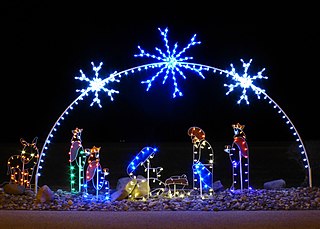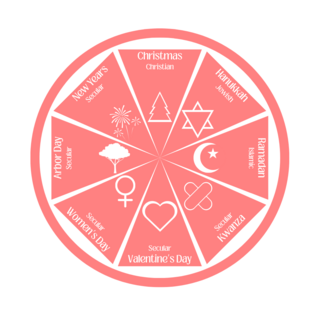Related Research Articles
April is the fourth month of the year in the Gregorian and Julian calendars. Its length is 30 days.

August is the eighth month of the year in the Julian and Gregorian calendars. Its length is 31 days.

Christmas is an annual festival commemorating the birth of Jesus Christ, observed primarily on December 25 as a religious and cultural celebration among billions of people around the world. A feast central to the liturgical year in Christianity, it follows the season of Advent or the Nativity Fast, and initiates the season of Christmastide, which historically in the West lasts twelve days and culminates on Twelfth Night. Christmas Day is a public holiday in many countries, is celebrated religiously by a majority of Christians, as well as culturally by many non-Christians, and forms an integral part of the holiday season surrounding it.

December is the twelfth and final month of the year in the Julian and Gregorian calendars. Its length is 31 days.
February is the second month of the year in the Julian and Gregorian calendars. The month has 28 days in common years or 29 in leap years, with the 29th day being called the leap day. It is the first of five months not to have 31 days and the only one to have fewer than 30 days. February is the third and last month of meteorological winter in the Northern Hemisphere. In the Southern Hemisphere, February is the third and last month of meteorological summer.

A holiday is a day or other period of time set aside for festivals or recreation. Public holidays are set by public authorities and vary by state or region. Religious holidays are set by religious organisations for their members and are often also observed as public holidays in religious majority countries. Some religious holidays, such as Christmas, have become secularised by part or all of those who observe them. In addition to secularisation, many holidays have become commercialised due to the growth of industry.
January is the first month of the year in the Julian and Gregorian calendars. Its length is 31 days. The first day of the month is known as New Year's Day. It is, on average, the coldest month of the year within most of the Northern Hemisphere and the warmest month of the year within most of the Southern Hemisphere. In the Southern hemisphere, January is the seasonal equivalent of July in the Northern hemisphere and vice versa.
March is the third month of the year in both the Julian and Gregorian calendars. Its length is 31 days. In the Northern Hemisphere, the meteorological beginning of spring occurs on the first day of March. The March equinox on the 20 or 21 marks the astronomical beginning of spring in the Northern Hemisphere and the beginning of autumn in the Southern Hemisphere, where September is the seasonal equivalent of the Northern Hemisphere's March.

May is the fifth month of the year in the Julian and Gregorian calendars. Its length is 31 days.
November is the eleventh and penultimate month of the year in the Julian and Gregorian Calendars. Its length is 30 days. November was the ninth month of the calendar of Romulus c. 750 BC. November retained its name when January and February were added to the Roman calendar. November is a month of late spring in the Southern Hemisphere and late autumn in the Northern Hemisphere. Therefore, November in the Southern Hemisphere is the seasonal equivalent of May in the Northern Hemisphere and vice versa. In Ancient Rome, Ludi Plebeii was held from November 4–17, Epulum Jovis was held on November 13 and Brumalia celebrations began on November 24. These dates do not correspond to the modern Gregorian calendar.

The New Year is the time or day at which a new calendar year begins and the calendar's year count increments by one. Many cultures celebrate the event in some manner. In the Gregorian calendar, the most widely used calendar system today, New Year occurs on January 1. This was also the first day of the year in the original Julian calendar and the Roman calendar.
The Revised Julian calendar, or less formally the new calendar and also known as the Milanković calendar, is a calendar proposed in 1923 by the Serbian scientist Milutin Milanković as a more accurate alternative to both Julian and Gregorian calendars. At the time, the Julian calendar was still in use by all of the Eastern Orthodox Churches and affiliated nations, while the Catholic and Protestant nations were using the Gregorian calendar. Thus, Milanković's aim was to discontinue the divergence between the naming of dates in Eastern and Western churches and nations. It was intended to replace the Julian calendar in Eastern Orthodox Churches and nations. From 1 March 1600 through 28 February 2800, the Revised Julian calendar aligns its dates with the Gregorian calendar, which had been proclaimed in 1582 by Pope Gregory XIII.

Memorial Day is a federal holiday in the United States for honoring and mourning the U.S. military personnel who died while serving in the United States Armed Forces. From 1868 to 1970, it was observed on May 30. Since 1971, it is observed on the last Monday of May.

Juneteenth is a federal holiday in the United States commemorating the end of slavery. Its name is a portmanteau of "June" and "nineteenth", as it is celebrated on the anniversary of June 19, 1865, when as the American Civil War was ending, Major General Gordon Granger ordered the final enforcement of the Emancipation Proclamation in Texas. Originating in Galveston, Juneteenth has since been observed annually in various parts of the United States, often broadly celebrating African-American culture.

In the Gregorian calendar, New Year's Day is the first day of the year; 1 January. Whilst most solar calendars begin the year regularly at or near the northern winter solstice, cultures that observe a lunisolar or lunar calendar celebrate their Lunar New Year at less fixed points relative to the solar year.

In the United States, public holidays are set by federal, state, and local governments and are often observed by closing government offices or giving government employees paid time off. The federal government does not require any private business to close or offer paid time off, as is the case for most state local governments, so employers determine which holidays to observe.
Tenth of Tevet, the tenth day of the Hebrew month of Tevet, is a fast day in Judaism. It is one of the minor fasts observed from before dawn to nightfall. The fasting is in mourning of the siege of Jerusalem by Nebuchadnezzar II of Babylonia—an event that began on that date and ultimately culminated in the destruction of Solomon's Temple, downfall of the Kingdom of Judah, and the Babylonian exile of the Jewish people.
The following are public holidays in Ukraine.
Chase's Calendar of Events is an annual American publication, started in 1957 by brothers William (Bill) D. Chase, and Harrison V. Chase. It includes special events, holidays, federal and state observances, historic anniversaries, and more unusual celebratory traditions. Bill Chase worked as a newspaper librarian and saw a need for "a single reference source for calendar dates, and for authoritative and current information about various observances throughout the year".
References
- ↑ The Missing Piece Puzzle Company. "What Is National Puzzle Day?". The Missing Piece Puzzle Company. Retrieved 28 December 2023.
- ↑ Calendar, National Day (27 December 2023). "NATIONAL PUZZLE DAY - January 29". National Day Calendar. Retrieved 28 December 2023.
- ↑ Puzzle to Play (13 January 2023). "National Puzzle Day 2024 - Puzzles to Play". Puzzle To play. Retrieved 28 December 2023.